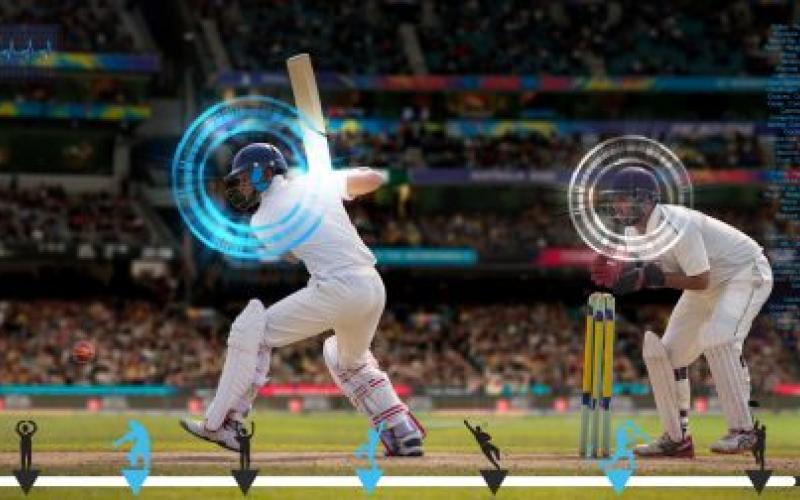
CRICKET IS NOT A SOLITARY game, and a single player has never been able to shoulder the responsibilities of the entire team. Technology has played an integral role to bind the spirit of the game alongside players, coaches, commentators, and fans. From its origins as rural recreation in England, in the 16th century, to its modern-day status as one of the most global sensational sports, technology has been instrumental in the evolution of international cricket and its dynamic formats.
If we were to categorize technological advancements into time periods, it could be argued that broadcasting or commentary advancements dominated the 20th century while coaching techniques and analytical advancements have been the focal point in the 21st century. From the 1930s to the 1980s, technology in cricket was deployed to bring the game closer to the fans. Television was a treasured item for a few; to bring cricket to the home of millions, the emphasis was on radio commentary. However, with the increasing popularity of televised cricket, special commentary rooms were established to enhance the viewing experience for the spectators. Today in 2023, when time is the most invaluable currency, technology has again lent itself to bringing the best of cricket in a few minutes in bite-sized videos or commonly said 'highlights'.
From the boomers to the zoomers
Over a century ago wagon wheel was created to show the batting innings of the batter’s scoreboard. It gave an in-depth analysis of batter’s agility to score cross-dimensional shots.
In 1985, Michael Stuart created the bowling machine with the intention of improving batting practice. The development of the bowling machine subsequently paved the way for other innovations in the coaching field. The Snickometer technology was invented by Alan Plaskett an English computer scientist and employed between India v/s Australia by Channel 4. It allowed the third umpires to make intricate decisions regarding catches and LBW appeals using audio and visual evidence.
Sachin Tendulkar was the first batter declared run out by Karl Liebenberg, the first third umpire. The idea for the third umpire technology in cricket was initially developed by the Sri Lankan team during domestic cricket matches in 1992, the role was to assist the on-field umpires in decision-making. Between 2001- 2004, the Hawk-Eye tech and the Spidercam were developed to track the trajectory of the ball. The camera technology enabled third umpires to assist with 3D ground data for confirming run-out decisions and displaying the emotional reactions of batters in case of dismissals and comprehensive video coverage.
The genesis of Algorithm
In 2008, the face of decision-making changed with the DRS, a technology-driven approach that aided third umpires in making more accurate decisions. Each team had the option to challenge the on-field umpire's decision by referring it to the third umpire through a player review in case of a dismissal. Technology took a giant leap thereafter with the induction of Smart bails, Ball spin RPM, Cricket Bat sensors, and Drones. In 1996, bowler Anil Kumble, an engineer by qualification, developed a software program resembling a data analysis scoring sheet. The Indian cricket team incorporated this digital system into their strategy, making it more engaging. Subsequently, artificial intelligence and deep learning algorithms were used for data analytics. The algorithms have the capability to examine massive quantities of data, comprising player performance metrics, field conditions, and match outcomes. These insights can assist coaches in making well-informed judgments about their team.
Artificial intelligently coached
Players and coaches utilize video analysis to scrutinize their performance, including batting and bowling techniques, fielding positions, and overall gameplay. This technological approach has streamlined the identification of improvement areas, allowing coaches to devise targeted training plans. Coaches leveraged live updates such as ball-by-ball progress reports and real-time video feeds in making informed decisions during matches. By harnessing the data, coaches dynamically adjust their strategies and make tactical decisions to enhance their team's prospects of winning.
Fan-mersed
In lucid terms, cricket is nothing less than a religion in some countries. AI has led to the development of futuristic data analytics tools that can analyze vast amounts of data, including player statistics, pitch conditions, and match results. The analysis provides valuable insights into the game, making it more engaging for fans and enthusiasts alike. Furthermore, AI has facilitated the creation of immersive fan experiences. Technologies like virtual reality and augmented reality have enabled fans to experience the game like never before. Fans can now immerse themselves in a virtual world where they can watch the game from different angles, get real-time updates, and interact with players and coaches.
From grassroots to stardom
Technology has been instrumental in propagating and popularizing women’s cricket by broadcasting high-quality content with live- streams that were dormant for years. The genesis of the Women's Premier League tournament marks a noteworthy achievement for the sport within the nation, and it indicates the commencement of a fresh phase for women's cricket. Brands have now begun investing in women’s cricket due to the increasing interest and support for the sport. The consequence of which is greater exposure for women's cricket. By offering a national stage for female cricketers to display their abilities and expertise, the tournament appeals to a more extensive audience and motivates young girls and women to pursue the sport. The Women's Premier League (WPL) has attained a total reach of 50.78 million (2+ years All India) within its first week of eight games, as reported by the Broadcast Audience Research Council (BARC) India. Technology has contributed to making the game gender-neutral, the way a sport is meant to be.
The future is soaring with human imagination and technology is making it all possible. In the very near future, the weather shall no longer be a barrier between a match and a fan with the plausibility of a retractable roof. More wearables are being designed to enhance the performance and recovery time of the players. With numerous cameras employed throughout the stadium, it is possible to transmit real-time data to a central hub and create a live virtual digital stadium. Online streaming could be a norm with personalized and interactive mediums at play. Forbes has remarked that the IPL’s most valuable franchise at $1.3 billion is worth more than six Major League Baseball teams or 27 NHL teams. The future propels change faster than anticipated, the change ensues; drama, action, and moolah for the entire cricket business
(Kapil Gadhire is Head Of Marketing, Magnifi by VideoVerse)
(The views expressed here are those of the Author and SportzPower need not necessarily subscribe to them)
- Log in to post comments
